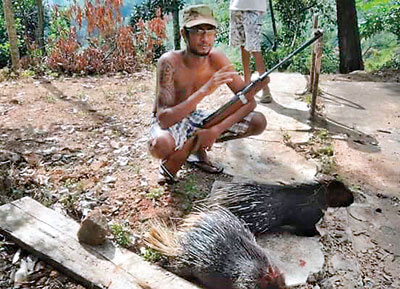News
Catching poachers on Facebook has rewards – and also dangers

One of the pictures posted on Facebook
There are pitfalls in using social media to expose animal cruelty and poaching, authorities warned although they expressed satisfaction with the arrests of six suspected poachers in the Knuckles Range last Sunday following posts on their activities on Facebook.
The poaching incident had occurred three and a half years ago but had only come to light when images of the suspects, posing with dead animals, had surfaced on Facebook after being uploaded by wildlife activists, police said.
It was the third instance of poaching suspects being exposed on social media and apprehended.
In March, two people were arrested for torturing a sea eagle after pictures on social media showed the endangered bird being skinned alive and its legs cut off.
Shortly after this incident, pictures of a person with a dead peacock went viral. This led officials to identify the suspect, who was a Sri Lankan national living in Italy. The suspect issued a statement claiming that the bird had been run over by a vehicle in Nikaweratiya.
Media Secretary to the Minister of Sustainable Development and Wildlife, Duminda Bandara welcomed the revealing social media posts. “It is a huge help for us to capture poachers, when [information] is posted on social media,” he said.
Mr. Bandara added that authorities had to beware of false images that might have been tampered with through applications such as Photoshop. He said, however, that this practice could be easily identified by CID and other police specialists. The authorities run background checks in order to identify perpetrators.
Once a photo is posted on social media a lot of people ask for information and this, if not regulated, will become a menace for officials, the Director of the National Wildlife Crime Prevention Unit, Mr. Irosha Perera, said. He said suspects could easily delete the information online or destroy any traces or leads that officials might have.
He gave an example: a month ago, officials had published a post asking for information about suspects. Other groups on Facebook published similar posts, asking for information.
“We injected misleading information into the posts and some suspects went to the site [of the crime] to destroy the evidence. They were arrested at the site for trespassing.”
The conservationist group, Rainforest Protectors of Sri Lanka, said social media was useful to track down poachers because it helps people to connect and spread awareness.
“One person might not be able to tackle a poaching issue, but through social media they can find information on honest authorities who are willing to carry on a raid,” a spokesperson for the group said.
Just two days ago, the spokesperson added, the organisation was contacted over social media by someone who had noticed a ring of fire in a forest reserve while having dinner at a hotel. It turned out to be a fire trap set up by poachers.
“The leaking of information prior to raids could help the poachers to hide their act. From the recent episodes, however, it seems the positives far outweigh the negatives,” the spokesperson added.
Environmental lawyer Jagath Gunawardana said social media was a powerful tool and as with all powerful tools, care had to be exercised.
“We have to use it through foresight and prudence. This is a new trend – uploading pictures of alleged suspects of poaching on Facebook. Whilst social media did play a vital role in aiding the apprehension of poachers in three instances, using this as a tool must be done so cautiously,” he said.He added that the first time a photo was posted on Facebook, asking for information relating to the torture of the sea eagle, several people had used the culprit’s profile and tagged him in the photos.
“Information has to be sought in a discreet manner. If we are not vigilant the culprits can know who is pursuing them,” he said adding that if information cannot be sought in a discreet fashion, then it must be taken to the public.
Mr. Gunawardana said certain groups acted irresponsibly in using the culprit’s name and urging the President to take action. Issues like this need to be handled responsibly: the authorities need to be informed discreetly, he said.
“So far there have been no instances of a mistake being made over [apprehending] a suspect but if caution is not taken a wrong person could end up being harassed,” Mr. Gunawardana said.

